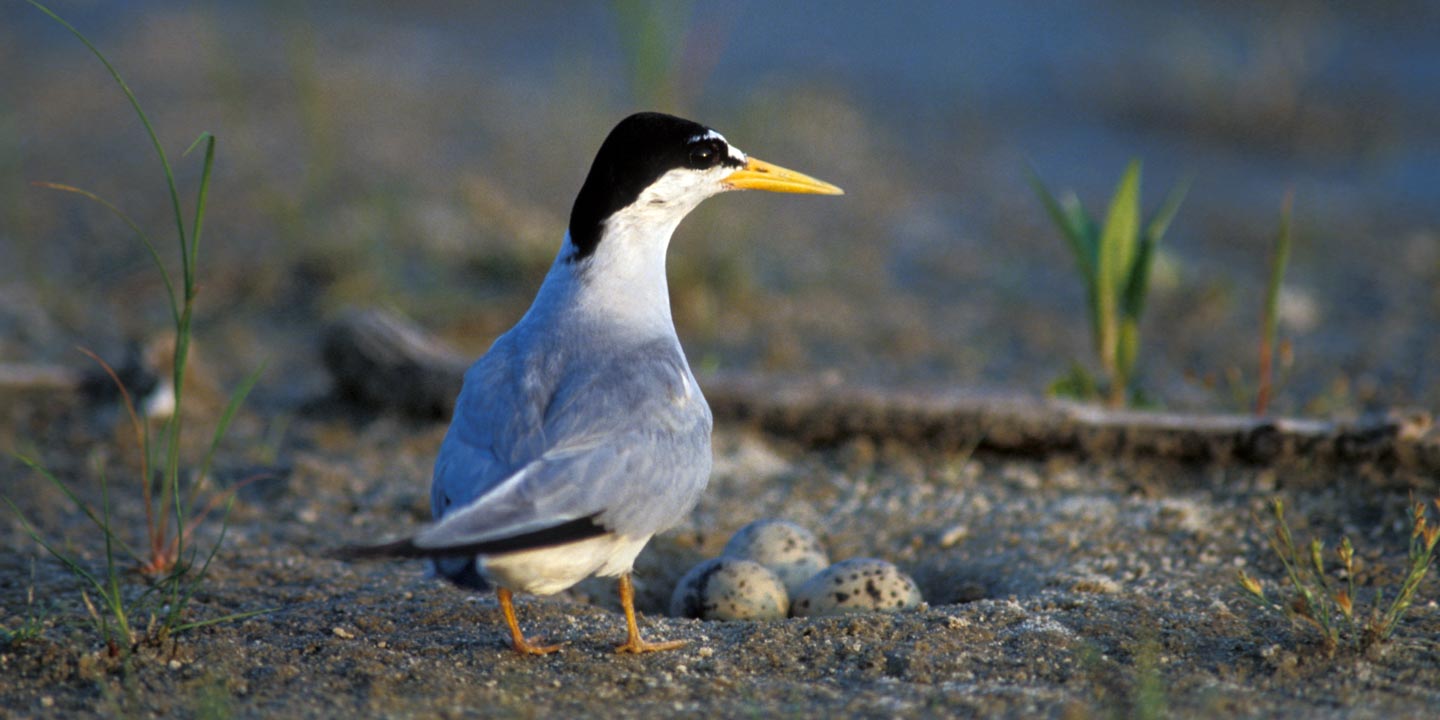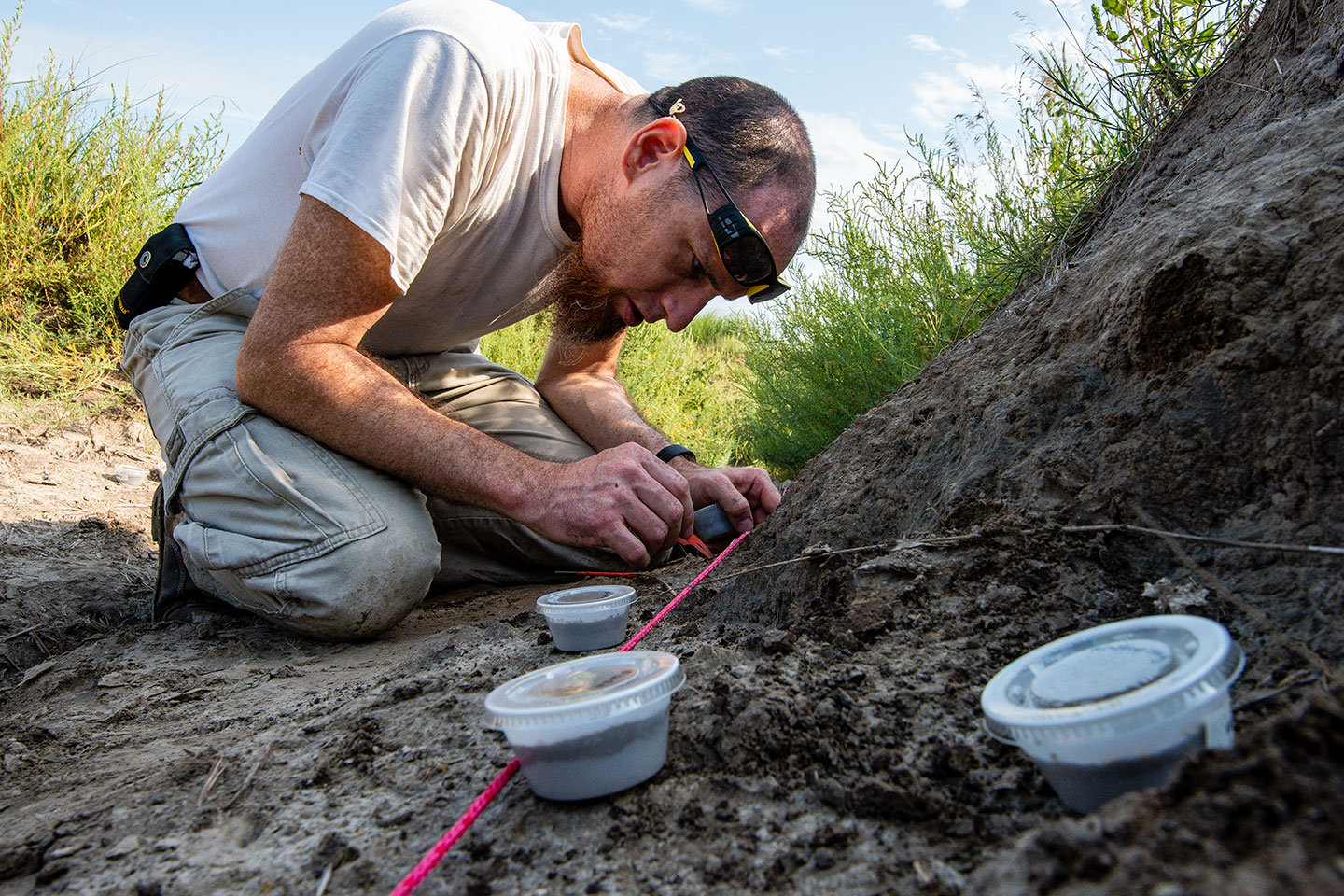Interior least tern
Status: Endangered

The interior least tern (Sternula antillarum athalassos) is a feisty, swallow-like bird measuring 8-9 inches long with a wingspan of 20 inches. It is the smallest tern species in North America. It was once called sea swallow for its delicate, graceful and buoyant flights over water.
Adult least terns have a black crown, white forehead and undersurface, pale gray back and wings and a black-tipped yellow-orange bill. The short legs and webbed feet of the male are orange while the females are pale yellow. The long, black outermost wing feathers and the short, deeply forked tail are conspicuous in flight. Immature least terns are darker gray than the adults. They have a dark bill, a dark gray eye stripe, a white forehead and a dusky brown cap.
Range
Historically, the breeding range of interior least terns extended from Texas to Montana and from Colorado and New Mexico to Indiana. Today, they occupy scattered areas of their former range.
Least terns arrive in Nebraska from their wintering grounds in Central and South America between mid-May and early June.
In Nebraska, the terns breed along the Platte, Niobrara and Missouri rivers. Isolated breeding colonies can also be found throughout the Elkhorn and Loup River systems. They migrate south beginning in mid to late August and winters along the Central American coast and the northern coast of South America from Venezuela to northeastern Brazil.

Habitat
Historically, interior least terns nested and raised their young on sparsely vegetated river sandbars, lakes and beaches. Today, they also nest on manmade sand and gravel mines, sandpit housing developments and reservoir shorelines. As these terns nest on the ground, areas that are flat with no vegetation are preferred so the birds can easily detect predators. Even more preferred are sandbars, which offer increased protection from mammalian predators that are deterred by the need to swim. Foraging habitat for these birds can be found in any body of water that contains small-bodied fish.
Diet
Interior least terns prey on small fish. When foraging, the terns hover over the water before diving in to catch a small fish in their bill. Adults and young birds swallow the fish whole, head first and usually in one gulp. They will also occasionally eat insects, but the vast majority of their diet is small fish.
Reproduction
Interior least terns establish nest sites upon returning to breeding grounds from their wintering grounds. Courtship occurs at or near the nest site. This courtship includes the “fish flight,” an aerial display involving pursuit and maneuvers ending in a fish transfer between the two birds. Other courtship behaviors include nest scraping, copulation and a variety of postures and vocalizations.
Least terns nest close to each other, which is a behavior termed colonial. To protect their nest and chicks, adult least terns dive-bomb, defecate on and shriek at intruders in a mobbing fashion to persuade the invader to leave the nesting colony.
Females lay two to three eggs directly on the sand, in a small bowl-shaped dugout. The eggs are incubated, by both male and female, for about three weeks. The chicks are a sandy-brown color with white under parts and tiny black spots on their head and back. This coloration helps camouflage the chicks in their sandy nest.
Chicks are able to leave the nest several hours after hatching, but remain dependent on their parents for protection and food until they are fledged (able to fly) around 21 days of age. Parental care continues after chicks have fledged, as the young birds learn to dive and catch fish. By 30 to 40 days of age, young terns are self-sufficient and begin their migration south in late August.
Population status
Historically, least terns were hunted in the 1800s for the commercial use of its feathers to decorate ladies’ hats. After the signing of the 1918 Migratory Bird Treaty Act, which prohibited the sale, purchase, taking or possession of any wild migratory bird or bird parts (such as feathers), commercial harvesting became illegal and the species population began to increase throughout the 1940s.
However, human development, habitat alteration, and habitat destruction in the form of river channelization and reservoir construction subsequently lead to another rapid population decline.
By the mid-1970s, least tern populations had decreased by more than 80 percent from the 1940s. The interior least tern was federally listed as endangered in 1985. Today, interior least terns are still facing threats of continued habitat loss, human disturbance, pollution and disease.
Management and outlook
In Nebraska, efforts continue to be made to monitor and protect nesting colonies, educate the public about this endangered species, and to restore, create and protect important river habitat.
In the recent past, numbers of interior least terns have increased in some areas, but populations are still endangered.
Conservation help
Landowners can help conserve least terns by reporting nesting sites to the Nebraska Game and Parks Commission at 402-471-0641.
Individuals can help by donating to conservation organizations dedicated to protecting threatened and endangered species. These donations provide much funding for needed research, habitat improvement projects and education.
References
Ducey, J. E. 1981. Interior least terns (Sterna antillarum athalassos). U.S. Fish and Wildlife Service. Pierre, South Dakota.
Tomkins, I. R. 1959. Life history notes on the least tern. Wilson Bulletin 71:313-322.
Hardy, J. W. 1957. The least tern in the Mississippi Valley. Publication of the Museum, Michigan State University, Biological Series 1:1-60.
U.S. Fish and Wildlife Service. 1990b. Endangered Species Act Section 7 Consultation-Federal Energy Regulatory Commission Project Nos. 1417-012 (Kingsley Dam) and 1835-025 (Keystone Dam). Letter from U.S. Fish and Wildlife Service, Grand Island, Nebraska, to Federal Energy Regulatory Commission, Washington, D.C.
U.S. Fish and Wildlife Service. 2003. Amendment to the Biological Opinion on Operation of the Missouri River Main Stem Reservoir System, Operation and Maintenance of the Missouri River Bank Stabilization and Navigation Project, and Operation of the Kansas River Reservoir System. December 16, 2003. 308 pp.
Wolk, R. G. 1974. Reproduction behavior of the least tern. Proceedings of the Linnaean Society, New York 72:44-62.
Copyright 2013. Published by the Nebraska Game and Parks Commission with funds from the Nebraska Environmental Trust.
NOTE: New data of the occurrence and distribution of this species are being collected constantly and some of the information in the pamphlet may be outdated. The information in this pamphlet should be used for a general understanding of the species and not as the sole source of range location for any report, project, regional or local planning, or for environmental impact assessments. For current information on this species, please contact the Nebraska Game and Parks Commission, Wildlife Division.




